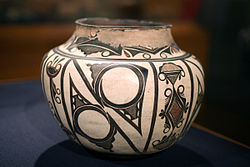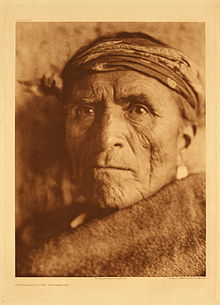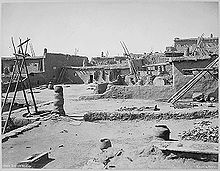|
Total population: 10,228 enrolled members (2000)
Regions with significant populations: United States (New Mexico)
Languages: Zuni, English
Religion: Zuni religion, Christianity (incl. syncretist forms)
Related ethnic groups: Hopi, Pueblo people
The Zuni (Zuni: A:shiwi; formerly spelled Zuñi) are a federally recognized Native American tribe, one of the Pueblo peoples. Most live in the Pueblo of Zuni on the Zuni River, a tributary of the Little Colorado River, in western New Mexico, United States. Zuni is 55 km (34 mi) south of Gallup, New Mexico. In addition to the reservation, the tribe owns trust lands in Catron County, New Mexico and Apache County, Arizona.
Demographics
In 2000, 10,228 people were enrolled in the Zuni tribe. According to the 2000 Census, there were approximately 7,790 people in the zip code of the Zuni reservation, with 7,619 living in either the statistical areas of Zuni or Blackrock. Tribal estimates for the entire reservation run from 10,000 to 12,000, with over 80% being Native Americans. Nearly half, or 43.0% of the population, lives below the poverty line as defined by the U.S. income standards.
History
Distribution of the Zuni language.
The Zuni, like other Pueblo peoples, are the descendants of Mogollon and Ancestral Pueblo peoples, who lived in the deserts of New Mexico, Arizona, Utah, and southern Colorado for over two millennia. The "village of the great kiva" near the contemporary Zuni Pueblo was built in the 11th century CE. A number of villages flourished in the 14th and 15th centuries, but by 1650, there were only six Zuni villages.
In 1539, Moorish slave Estevanico led an advance party of Fray Marcos de Niza's Spanish expedition. The Zuni killed him as a spy. This was Spain's first contact with any of the Pueblo peoples. Francisco Vasquez de Coronado traveled through Zuni Pueblo. Spaniards built a mission at Hawikuh in 1629. The Zunis tried to expel the missionaries in 1623, but Spanish built another missoin in Halona in 1643.
Before the Pueblo Revolt of 1680, the Zuni lived in six different villages. After the revolt, until 1692, they took refuge in a defensible position atop Dowa Yalanne, a steep mesa 5 km (3.1 miles) southeast of the present Pueblo of Zuni; Dowa means "corn", and yalanne means "mountain". After the establishment of peace and the return of the Spanish, the Zuni relocated to their present location, only briefly returning to the mesa top in 1703.
The Zunis were self-sufficient during the mid-19th century, but faced raiding by the Apaches, Navajos, and Plains Indians. Their reservation was officially recognized by the United States federal government in 1877. Gradually the Zuni farmed less and turned to sheep and cattle herding as a means of economic development. Frank Hamilton Cushing, a pioneering anthropologist associated with the Smithsonian Institution, lived with the Zuni from 1879 to 1884. He was one of the first participant observers and an ethnologist.
A controversy during the early 2000s was associated with Zuni opposition to the development of a coal mine near the Zuni Salt Lake, a site considered sacred by the Zuni and under Zuni control. The mine would have extracted water from the aquifer below the lake and would also have involved construction between the lake and the Zuni. The plan died in 2003 after several lawsuits.
Culture
The Zuni traditionally speak the Zuni language, a unique language (also called an "isolate") which is unrelated to any other Native American language. The Zuni continue to practice their traditional religion with its regular ceremonies and dances, and an independent and unique belief system The Zuni were and are a peaceful, deeply traditional people who live by irrigated agriculture and raising stock. Their success as a desert agri-economy is due to careful management or conservation of resources, as well as a complex system of community support. Many contemporary Zuni also rely on the sale of traditional arts and crafts. Some Zuni still live in the old-style Pueblos, while others live in modern flat-roofed houses made from adobe and concrete block. Their location is relatively isolated, but they welcome respectful tourists.
The Zuni Tribal Fair and rodeo is held the third weekend in August. The Zuni also participate in the Gallup Inter-Tribal Ceremonial, usually held in early or mid-August.
Zuni Pottery

Zuni olla, late 19th c. early 20th century, 12.5" high, Brooklyn Museum
Traditionally, Zuni women made pottery for food and water storage. They used symbols of their clans for designs the women would use. Clay for the pottery is sourced locally. Prior to its extraction, the women give thanks to the Earth Mother (Awidelin Tsitda) according to ritual. The clay is ground, and then sifted and mixed with water. After the clay is rolled into a coil and shaped into a vessel or other design, it will be scraped smooth with a scraper. A thin layer of finer clay, called slip, is applied to the surface for extra smoothness and color. The vessel is polished with a stone after it dries. It is painted with home-made organic dyes, using a traditional yucca brush. The intended function of the pottery dictates its shape and images painted on its surface. To fire the pottery, the Zuni used animal dung in traditional kilns. Today Zuni potters might use electric kilns. While the firing of the pottery was usually a community enterprise, silence or communication in low voices was considered essential in order to maintain the original "voice" of the "being" of the clay, and the purpose of the end product. Sales of pottery and traditional arts provide a major source of income for many Zuni people today. An artisan may be the sole financial support for her immediate family as well as others. Many women make pottery, clothing, and baskets.
Zuni also make fetishes carvings and necklaces for the purpose of rituals and trade, and more recently for sale to collectors. The Zuni are known for their fine silversmithing, which began in the 1870s after they learned fundamental techniques from the Navajo. Lanyade was the first Zuni silversmith, who learned the art from Atsidi Chon, a Navajo smith. By 1880, Zuni jewelers set turquoise in silver. Today jewelry making thrives as an art form among the Zuni. Many Zuni have became master silversmiths and perfected the skill of stone inlay. They found that by using small pieces of stone, they were able to create intricate designs and unique patterns. Small oval-shaped stones with pointed ends are set close to one another and side by side. The technique is normally used with turquoise in creating necklaces or rings. Another craft they have mastered is needlepoint.
Religion

Lutakawi, Zuni Governor, photographed before 1925 by Edward S. Curtis

Zuni pueblo in 1879
Religion is central to Zuni life. Their religious beliefs are centered on the three most powerful of their deities: Earth Mother, Sun Father, and Moonlight-Giving Mother, as well as Old Lady Salt and White Shell Woman, as well as other katsinas.
Zunis have a cycle of religious ceremonies. Each person's life is marked by important ceremonies to celebrate the passage of certain life milestones. Birth, coming of age, marriage and death are especially celebrated.
The Zuni make a religious pilgrimage every four years on the Barefoot Trail to Koluwala:wa, also called Zuni Heaven or Kachina Village; a 12,482-acre (50.51 km2) detached portion of the Zuni Reservation about sixty miles southwest of Zuni Pueblo. The four-day observance occurs around the summer solstice. It has been practiced for many hundreds of years and is well known to local residents.
Another pilgrimage conducted annually for centuries by the Zuni and other southwestern tribes is made to Zuni Salt Lake. They harvest salt during the dry months, and celebrate religious ceremonies. The lake is home to the Salt Mother, Ma'l Okyattsik'i, and is reached by several ancient Pueblo roads and trails.
Coming of age, or rite of passage, is celebrated differently by boys and girls. A girl who is ready to declare herself as a maiden will go to the home of her father's mother early in the morning and grind corn all day long. Corn is a sacred food and a staple in the diet of the Zuni. The girl is declaring that she is ready to play a role in the welfare of her people.
When it is time for a boy to become a man, he will be taken under the wing of a spiritual 'father', selected by the parents. This one will instruct the boy through the ceremony to follow. The boy will go through certain initiation rites to enter one of the men's societies. He will learn how to take on either religious, secular or political duties within that order.
For More Information:
Zuni Indian Fact Sheet for Kids 
|